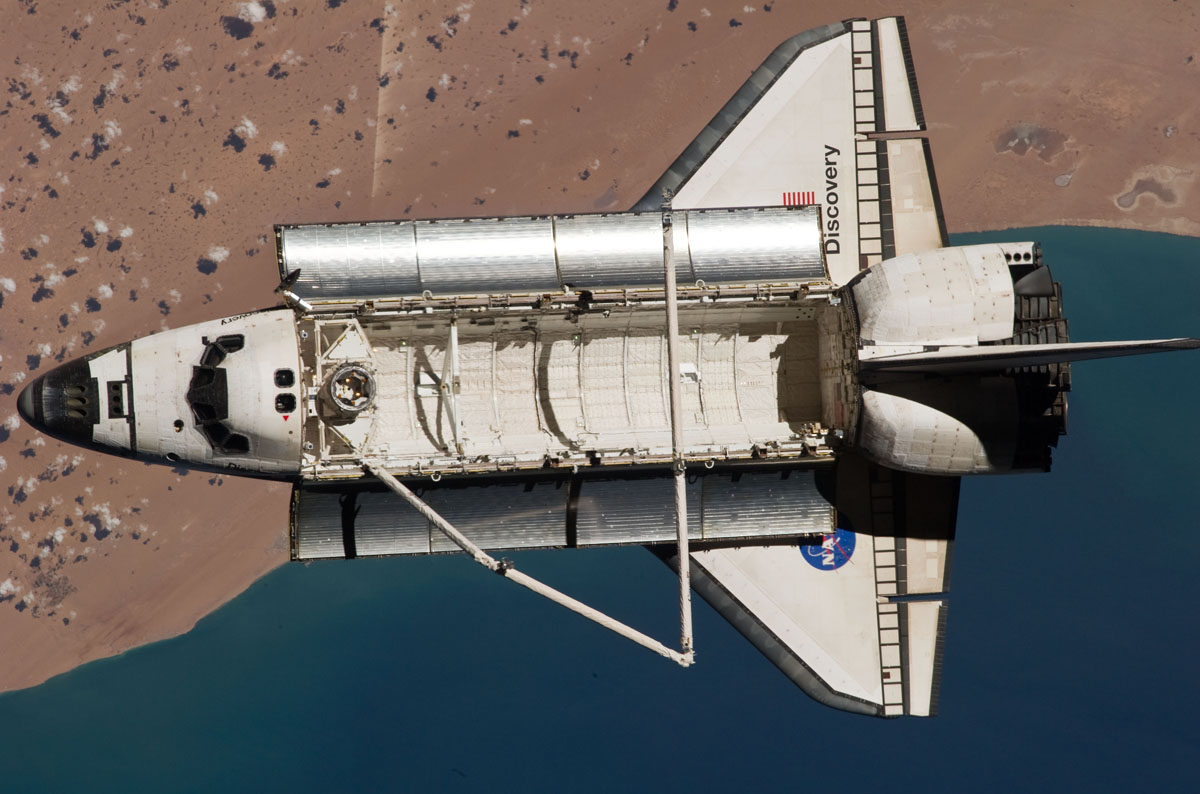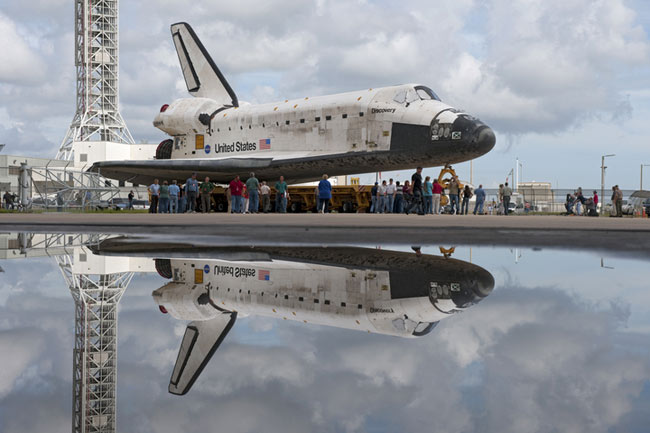Space Shuttle Discovery: 5 Surprising Facts About NASA's Oldest Orbiter

The space shuttle Discovery is going on display at the Smithsonian Institution's National Air and Space Museum just outside Washington, D.C., this week after taking one last flight atop its a modified Boeing 747 jet from NASA's Florida spaceport on Tuesday (April 17).
Discovery was the leader of NASA's space shuttle fleet, which retired in July after 30 years of service. The storied shuttle is the oldest of NASA's three remaining space-flown orbiters, and first blasted off in 1984. (The shuttles Columbia and Challenger debuted earlier, but both were lost along with their crews in tragic accidents.)
Here are five interesting, and perhaps surprising, facts about the shuttle Discovery, which is due to be towed to the Smithsonian's Steven F. Udvar-Hazy Center in Chantilly, Va., on Thursday (April 19):
1. Discovery is really dirty
Discovery's somewhat dingy appearance surprises many people who see the orbiter up close. But it would be strange if the shuttle gleamed a crisp, factory-floor white, considering how many times it's been to space and back (see below). [10 Cool Facts About Shuttle Discovery]
"When you look at her up close, she does look worn," said NASA's Stephanie Stilson, who managed Discovery's processing flow between the orbiter's missions from 2000 to 2011. "There are discolorations and streaks from going from orbit back into our environment here."
Those streaks were inflicted primarily during re-entry to Earth's atmosphere, when Discovery experienced temperatures of up to to 3,000 degrees Fahrenheit (1,650 degrees Celsius).
Breaking space news, the latest updates on rocket launches, skywatching events and more!
2. It's the world's most-flown spacecraft
Discovery flew 39 space missions during its operational life, more than any other space shuttle — or any other spacecraft in history, for that matter.
The orbiter blasted off for the first time in August 1984 and touched down for good in March 2011. Over the course of its 39 flights, Discovery logged a total of 365 days in space and put 148,221,675 miles (238,539,663 kilometers) on its odometer. That's the equivalent of more than 300 roundtrips to the moon.
For comparison, the shuttle Atlantis flew 33 times, and Endeavour lifted off the pad 25 times. Columbia and Challenger notched 28 and 10 space missions, respectively, in their tragedy-shortened careers.
3. It deployed the Hubble Space Telescope
Astronauts aboard Discovery deployed NASA's Hubble Space Telescope on the shuttle's STS-31 mission in April 1990. Five subsequent missions, launched aboard a variety of shuttles, repaired and upgraded the sensitive instrument.
Hubble celebrates its 22nd anniversary in space this year and continues to snap stunning photos that increase our understanding and appreciation of the cosmos to this day. In 2011, it made its millionth science observation.
4. It brought NASA back from tragedy, twice
Discovery was the first shuttle to launch after each of the shuttle program's two fatal tragedies, the January 1986 loss of Challenger shortly after liftoff and the Feburary 2003 destruction of Columbia as it re-entered Earth's atmosphere. Each disaster took the lives of all seven astronauts aboard.
In both cases, the shuttle program took several years to get back on its feet. Discovery's return-to-flight missions launched in September 1988 and July 2005, respectively, following substantial safety modifications for the orbiter fleet.
5. Discovery flew one of NASA's original astronauts
Discovery is the only shuttle ever to fly one of the Mercury Seven — NASA's first astronaut class, which was chosen in 1959. The orbiter carried John Glenn on its STS-95 mission in October 1998, when the astronaut (and sitting U.S. senator) was 77 years old.
On the flight, Glenn became the oldest person ever to reach space. Thirty-six years earlier, in 1962, he had become the first American to orbit Earth.
Discovery broke other barriers as well. It was the first American spacecraft to be piloted by a woman, for example. NASA astronaut Eileen Collins piloted the shuttle's STS-63 mission in 1995. (Collins also became the first female shuttle commander in history on Columbia's STS-93 mission in 1999, which deployed NASA's Chandra X-ray Observatory.)
Note: An earlier version of this story stated that Discovery flew the STS-93 mission in 1999. Columbia actually made that flight, and the story has been corrected to reflect that fact.
You can follow SPACE.com senior writer Mike Wall on Twitter: @michaeldwall. Follow SPACE.com for the latest in space science and exploration news on Twitter @Spacedotcom and on Facebook.

Michael Wall is a Senior Space Writer with Space.com and joined the team in 2010. He primarily covers exoplanets, spaceflight and military space, but has been known to dabble in the space art beat. His book about the search for alien life, "Out There," was published on Nov. 13, 2018. Before becoming a science writer, Michael worked as a herpetologist and wildlife biologist. He has a Ph.D. in evolutionary biology from the University of Sydney, Australia, a bachelor's degree from the University of Arizona, and a graduate certificate in science writing from the University of California, Santa Cruz. To find out what his latest project is, you can follow Michael on Twitter.

